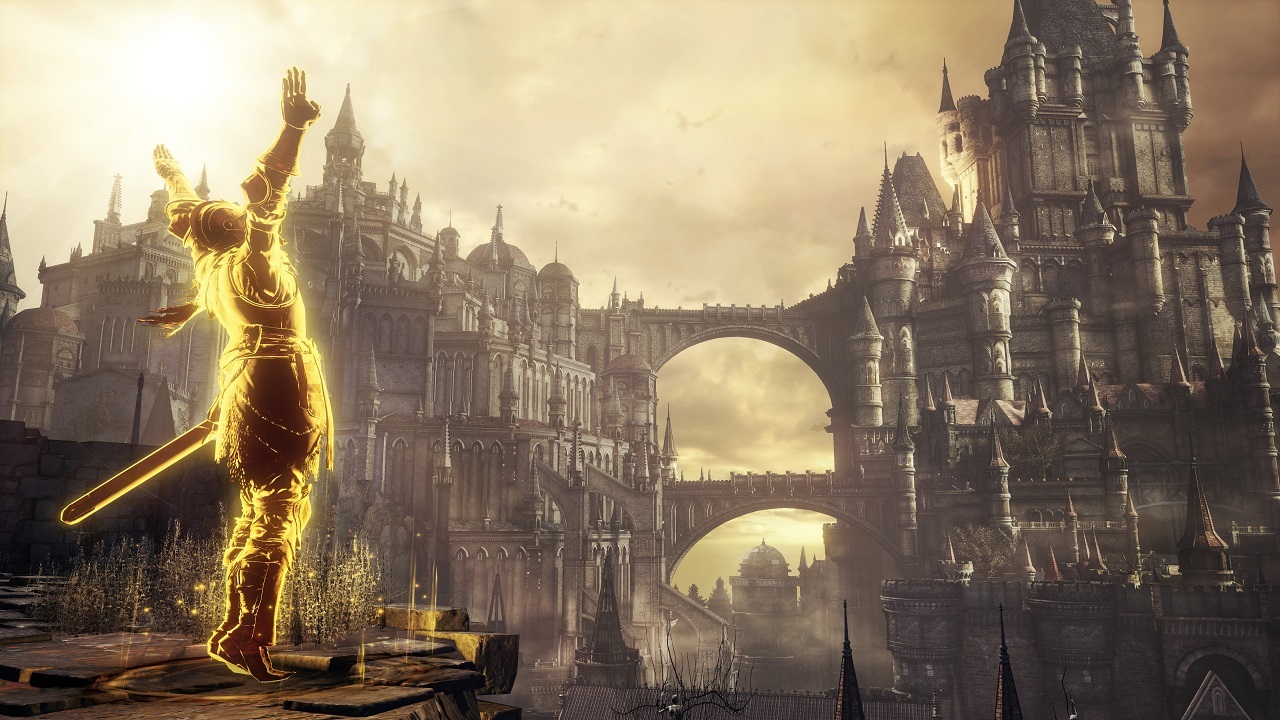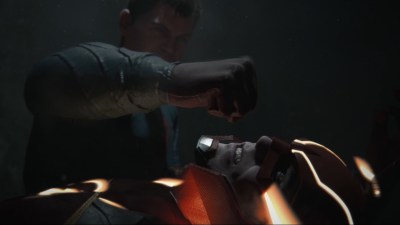There’s a 3 at the end of the title, but this is Hidetaki Miyazaki’s fifth stab at perfecting the Souls formula.
Starting with PS3-exclusive Demon’s Souls in 2009, and a grassroots movement that saw an otherwise niche title begin its ascent into one of the biggest forces in the games industry, the Souls games - which include spiritual cousin Bloodborne - have had an odd upwards trajectory that must have caught the designer off guard. How was Miyazaki to know that a deliberately brutally difficult game, designed to channel the spirit of the relatively unknown King’s Field series, would go on to reach the critical and commercial success that it has?
Imagine the pressure that he must feel, each time he sits down to conceive the next installment.
Demon’s Souls was the runaway success story. Dark Souls took that success multiplatform, cementing the series’ reputation. Dark Souls 2 was seen by some as a slight wobble on the quality scale, Miyazaki’s relegation to a supervisory role often cited as evidence of how fundamental his input is. Then came Bloodborne, a tour-de-force of design and Lovecraftian swagger which blew away the competition last year.
And now we have Dark Souls 3. Is it better than Bloodborne? Is it the end of the series (Miyazaki has made conflicting statements on the matter)? Is it better than Dark Souls 2, and should you buy it?
PRAISE THE SUN!
The simple answer to that last question is that yes, you should buy Dark Souls 3. It’s an absolutely stunning game: one that blends the lessons learned over the course of the series into something familiar, but altogether new. Dark Souls 3 is what Demon’s Souls wanted to be; what Dark Souls 2 wasn’t; and what Bloodborne hinted at for the future.
Let’s start from the top, and discuss the world. Lordran - specifically the city of Lothric - is your dying ground here. Lothric’s relation to Dark Souls games past, and where it sits along the series timeline, is something that will fuel a thousand fan discussions in the weeks and months to come. On a purely visual level, we’re in familiar territory: high fantasy and with an atmosphere which resides somewhere between outright nihilism and total despair, Lordran manages to be beautiful in its depiction of a fantasy wasteland. The Souls games have always concerned themselves with putting the player into a world long past the point of apocalypse.
Dark Souls 3 is no different; while the visual language is familiar, the increased rendering power afforded by a new generation of hardware and the engine which fuelled Bloodborne affords the player a visual treat. Ash and fire is the watchword this time around. Whether you’re using Ember (Dark Souls 3‘s interpretation of the Humanity system from games past) in order to strengthen yourself and summon others, kindling the many bonfires - which sit somewhere between the first and second games in terms of their prevalence - or watching the ash fall as you stand in one of the many ruined districts of Lothric, Miyazaki has ensured that the world of Dark Souls 3 is both beautiful and simultaneously intimidating. The sheer volume of player messages gushing about the gorgeous vistas suggests that I’m not alone in that assessment.
In terms of layout, the world feels more cohesive this time around as well. In Dark Souls 2 many areas were juxtaposed in such a way that the shift in tone and geography felt jarring. Dark Souls 3‘s world feels far more believable in comparison. Indeed, many areas - and your route through them - feel almost as though you’re seeing the same world as the first Dark Souls, only in a different era. The structure of the game feels more linear than before: with one notable exception, the way forward is always clear, and you rarely have multiple options available to you. In addition, many of the zones feel like parallels of those from the first game, which means that a sense of over-familiarity may creep in for series veterans. Lore junkies have plenty to pick through though when it comes to piecing together the series’ infamously inscrutable story. Lothric is a place steeped in history, and while the series has never been known to beat players over the head with exposition, a lot can be gleaned from the many item descriptions.
The atmosphere is bleak. This is a Souls game, after all - could the atmosphere be anything but? But what I can say with a good amount of confidence is that even if Dark Souls 3 doesn’t turn out to be the end of the series, it does feel like the end of an era - from a story perspective, at least. The endings feel as definitive as they can be for a Souls game. And, in keeping with tradition, they are are all painted in various moral shades of grey - some darker than others. Dark Souls has always felt like a series about repeating cycles - the most depressing version of Groundhog Day you can imagine - with the players and events caught in an endless loop of death, despair and decay. Dark Souls 3 puts a cap on that, suggesting that if there is a fourth game in the future, we could end up looking at something with a significantly different tone.
PREPARE TO DIE
FROM has loaded Dark Souls 3 with some of the most difficult bosses seen by the series to date. Good luck with The Nameless King (no, seriously - good luck. You’ll need it). FROM’s propensity for utter bastards who you will hate until the end of time shows no sign of slowing down. The bosses in Dark Souls 3 are among the series’ best, and sometimes its most difficult.
That said, overall the difficulty feels more accessible this time around. Dark Souls 2 delighted in spamming players with cheap deaths that they could not have possibly foreseen (remember that rolling boulder in the Forest of Fallen Giants?). Dark Souls 3 is still tough as nails, of course - but the level design and enemy placement seems a lot more respectful towards the player compared to the second game. Just remember to check the corner behind you whenever you enter a seemingly empty room - and don’t trust the treasure chests.
Covenants - Dark Souls’ implementation of assymetric multiplayer - return. In Dark Souls 2, Covenants were perhaps a little too focused on PvE. In Dark Souls 3, there’s more of a balance between Player versus Environment and Player versus Player. One new Covenant - the Mound Makers - acts as a wild card and sits somewhere between the two. Summon a purple Phantom, and you never know what you’re going to get: they may be friendly, or they may immediately go for your jugular. They’re the wild card in the deck, basically, and some of the best experiences in the game come from summoning a purple Phantom and preparing for a fight, only for them to suddenly start helping you out instead. After they’ve greeted you with a bow, of course - even in a game with a reputation as intimidating as Dark Souls, most players have a sense of etiquette. Some areas seem to have been adopted by the community as designated duelling arenas, and makeshift duelling guilds have already sprung up. Duelling in designated safe zones feels a little contrary to the spirit of the series, but you’ll still find your game invaded at random.
Some of those invasions, of course, are by NPCs. Easily identified by their names (Yellowfinger Heysel feels a little more canonical than L33TGAM3R1996, after all), the NPC phantoms put up a good fight, and often grant tempting new weapons and equipment on death.
They also have a tendency to show up in the most unexpected places. A tough battle against a couple of Knights is made worse when there’s a phantom hunting you down in a swamp infested by giant crabs; a quiet stroll down a cliffside can see your admiration of the view interrupted by being promptly pushed off the edge and into the abyss. Getting your own back is mightily satisfying - and occasionally you may then be able to summon them as allies in a later boss fight.
“OOH, YET TO GIVE IN, EH?”
Dark Souls 3‘s quality does occastionally wobble, however. When it comes to the difficulty curve, some late-game bosses are walkovers, while earlier bosses will have you pulling your hair out. Difficulty is a subjective thing in any game, of course; but there are more peaks and troughs in Dark Souls 3 than in previous games. And the difficulty ramps up significantly at around the halfway point, which could see your progress slowed until you adapt to a tough new set of enemies. My first playthrough took me around 50 hours, with a good amount of that time spent at a couple of chokepoints.
My second journey through Lothric saw that figure slashed to around 10-15, though - mainly by virtue of knowing where I was going, and already knowing the attack patterns of enemies. I’m currently midway through my third playthrough, and I know that I’m going to go right back into a fourth once I’m done. Dark Souls remains as addictive as ever. Even when it’s making you shout at the TV in frustration because you failed to recover 165,000 souls before dying again, Dark Souls 3 retains the series’ trademark one-more-go appeal that sees you wading back into the fray.
Unfortunately, not all of your deaths will be your own fault. A couple of late-game areas see framerates dropping to the equivalent rates of Blightown from the first Dark Souls, and are made particularly more frustrating by the sheer number of encounters you’ll come up against. On several occasions, I swung the camera around only to see RGB wireframe geometry. Entire areas would pop into view just 3 feet in front of me, and I experienced a number of occasions where the game simply crashed and returned me to the title screen because it lost the server connection. A patch has been issued that was supposed to correct this, but it seems to have had no effect on the problem - even post-patch, I was promptly returned to the title screen every time the connection dropped. Dark Souls 3 is the most technically accomplished title that FROM has produced to date - but it’s not particularly well-optimized on any format. Ambition has once again proven to be FROM’s downfall.
But none of this detracts from the fact that Dark Souls 3 stands tall as the best installment in the series to date. As an evolution and refinement of familiar mechanics, it’s a wonderful maybe-send off. Taken in isolation, it’s among the best gaming experiences of the current generation. You’ll die, you’ll cry, you’ll die again - but you’ll keep on playing, then cheer when you finally triumph over a boss on your 20th attempt. And once you’re finished and the credits have rolled, you’ll still want to keep playing - to find those hidden areas, or start a new journey with your stats and equipment intact. There’s no higher compliment that you can give to a game than to say that you never want it to end.
And if that’s not enough reason to praise the sun, then I don’t know what is.






